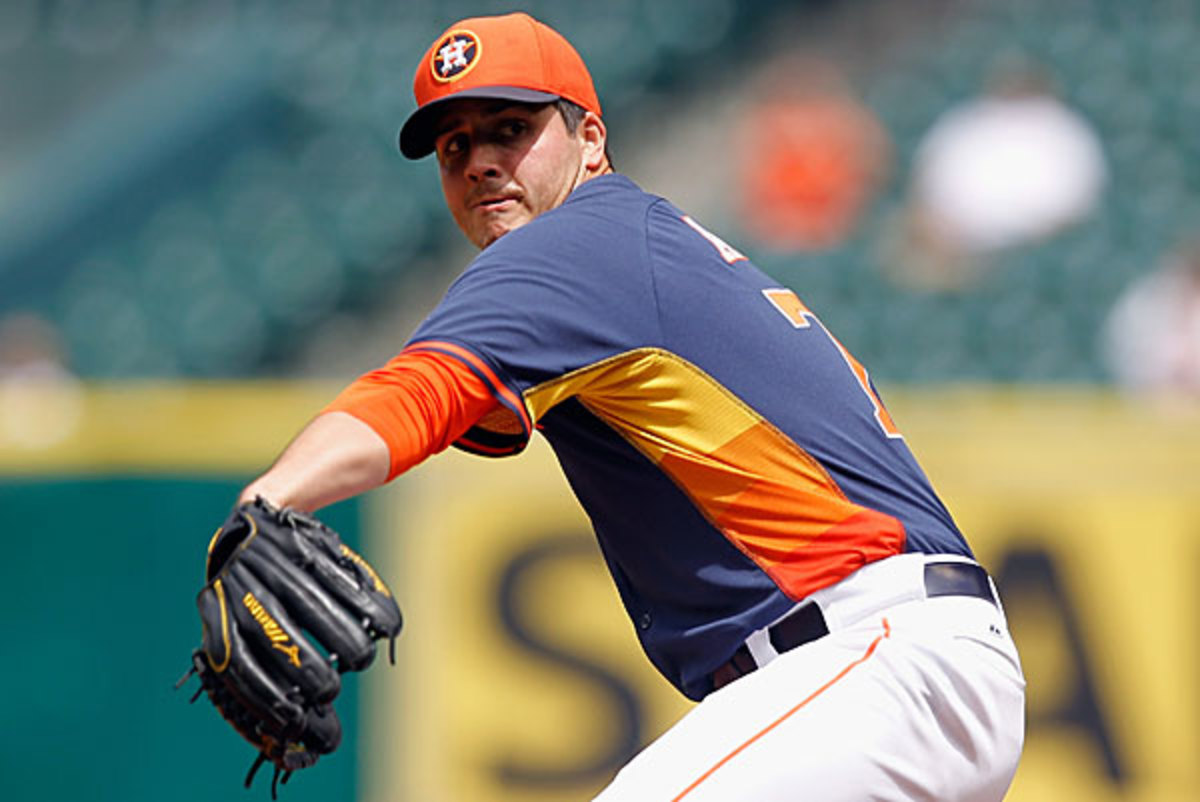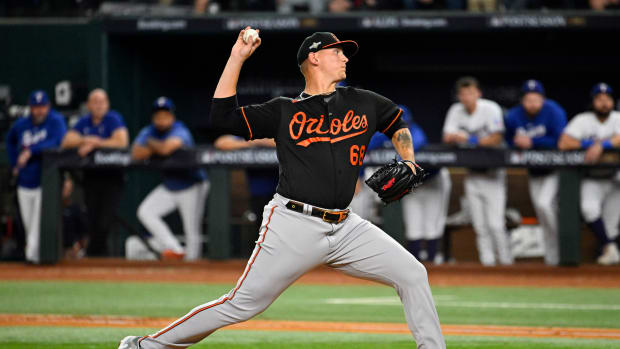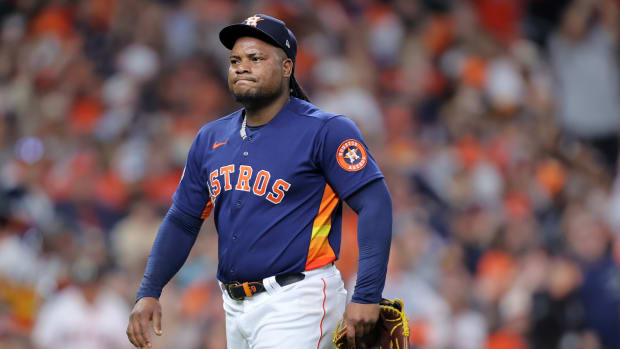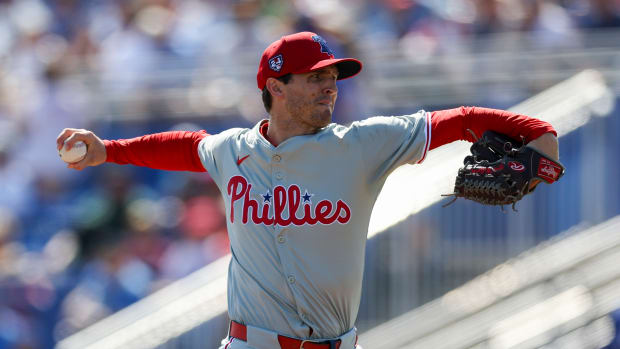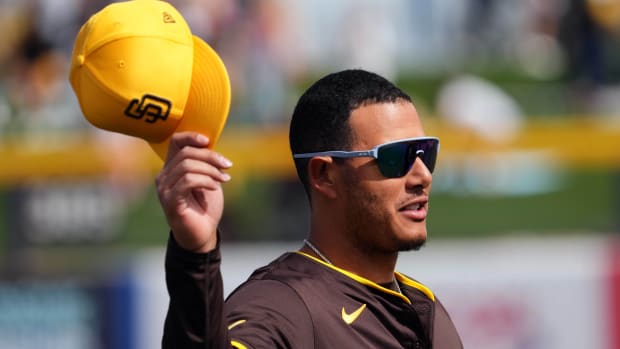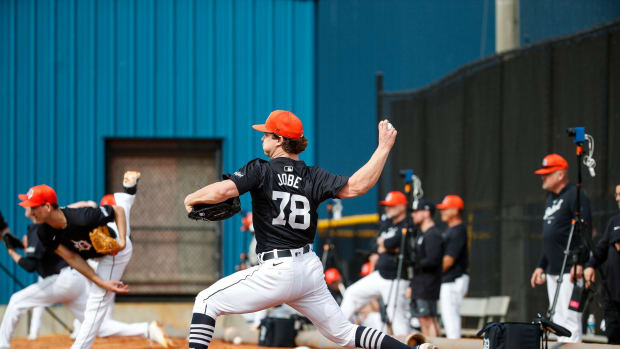Breaking down history of when No. 1 overall picks reach the major leagues
Mark Appel, the top pick in last year's draft, has had a rocky season in the minors this year. (Bob Levey/AP)
Holding the first pick of the amateur draft for the third straight year, the Astros on Thursday night chose Brady Aiken, a 17-year-old left-handed pitcher out of a San Diego high school. It was just the third time since the draft's inception in 1965 that a team selected a high school pitcher at numero uno, and Houston will have to hope he writes a better ending to his story than the first two, David Clyde and Brien Taylor.
Clyde, the first overall pick by the Rangers in 1973, was rushed to the majors just three weeks and a day after being selected — 19 days after his high school graduation — without the benefit of a single minor league start to give a decrepit franchise an attendance boost. Though he earned the win in a wobbly five-inning start, the balance of his results that season were predictably terrible: a 5.01 ERA (74 ERA+) in 18 starts. He totaled just 416 1/3 innings in his major league career before disappearing after his age-24 season due to arm troubles. Taylor, the 1991 number one selection by the Yankees, climbed as high as Double A before dislocating his shoulder and tearing the capsule in a bar fight; he never reached the majors.
The draft history thus offers relatively few hints as to how quickly Aiken will get to the big leagues or become a rotation regular. However, if we study the history of number one overall picks, we can better appreciate the risk the Astros took in selecting him, and also place their No. 1 picks from the last two years -- high school shortstop Carlos Correa and college pitcher Mark Appel -- in context.
CORCORAN: The best and worst No. 1 overall picks ever
Excluding those three picks and the first of two times that Danny Goodwin was chosen number one (1971 by the White Sox), 46 players have gone 1-1. All but three — Taylor, Steve Chilcott (1966, Mets) and Matt Bush (2004, Padres) — reached the majors. For each one, I mined Baseball-Reference.com to record how many seasons after being drafted it took for a player to a) debut in the majors; b) contribute at a level of 200 plate appearances or 50 innings pitched in a season; c) qualify for a batting title (502 plate appearances) or ERA title (162 innings); and d) post a 2.0 WAR season, the rough equivalent of a league-average regular or an outstanding part-timer. Some of those cutoffs are admittedly arbitrary, but they'll suffice to provide a picture. I then aggregated the 46 players into four groups based on whether they were drafted out of high school or college, and were pitchers or position players.
Group | Total | Career WAR | Debut | Bust-D | Contrib | Bust-C | Qual | Bust-Q | Avg | Bust-A |
HS Pos | 20 | 30.1 | 2.9 | 10% | 4.1 | 20% | 4.5 | 30% | 5.1 | 30% |
HS Pitch | 2 | 0.7 | 0.0 | 50% | 0.0 | 50% | -- | 100% | -- | 100% |
Coll Pos | 11 | 16.8 | 1.3 | 0% | 2.0 | 9% | 2.8 | 9% | 3.0 | 9% |
Coll Pit | 13 | 14.0 | 1.6 | 0% | 2.0 | 8% | 3.8 | 23% | 4.1 | 31% |
"Total" is the number of players in each group, "Avg WAR" is the average Baseball-Reference.com Wins Above Replacement total for the group including only those players who made the majors. "Debut," "Contrib," "Qual" and "Avg" are the average number of seasons between being drafted and attaining the given level described above; note that for each, I used only whole numbers, so the decimal isn't strictly meant to imply months or games. The "Bust" categories represent the percentage of players from the total in that bin who did not attain that level at any point in their careers.
High school pitchers
The smallest group by far is that of high school pitchers, and it's not hard to see why; as noted, both Clyde and Taylor were utter disasters for different reasons. Clyde maxed out at 153 1/3 innings and 1.1 WAR in 1978 — that after spending the better part of three seasons in the minors and on the disabled list — thus never qualifying for an ERA title or reaching an average season.
High school position players
This is the largest group of number ones, and it has the highest yield in terms of WAR, though it also requires the most patience and presents a relatively high risk of busting, according to most standards. The average high school hitter takes nearly three seasons to reach the majors, four to start contributing meaningfully and five to reach league average; anywhere from 10 to 30 percent never reach the various plateaus. The average WAR for this group is around double that of college players — position or pitcher — though it's skewed by the tremendous value produced by Hall of Fame-caliber talents Alex Rodriguez (116.0 WAR), Chipper Jones (85.0) and Ken Griffey Jr. (83.6); the median WARs for the two groups of position players are about the same (17.6 for high school, 16.7 for college). The average times to debut and contribute are around double those of college position players, though the classes converge when qualifying or attaining average are considered. No high school position player ever debuted in the same year he was drafted, and only three -- A-Rod (1993, Mariners), Jeff Burroughs (1969, Rangers) and Mike Ivie (1970, Padres)) were even in the majors the next year. Griffey was the quickest to attain average-or-better production, doing so in his second season (1989) after being chosen by Seattle.
Thus the data suggests that Correa would reach the majors in 2015 and begin contributing substantially in 2016, though he may not become an average regular until 2017. Based on his progress so far, that appears to be about right. He's raking this season (.329/.416/.502) at High-A Lancaster in the hitter-friendly California League at age 19. Based on the service time-minded precedents of recently called up Astros George Springer and Jonathan Singleton, it's doubtful Houston will fast-track Correa for a cup of coffee this year or even allow him to achieve Super Two status by debuting in the first half of 2015.
College pitchers
This is a relatively fast-moving group, debuting an average of 1.6 seasons after being chosen No. 1 overall, and generally reaching the contributing plateau in their second season after the draft. Ben McDonald (1989, Orioles) was the only one to debut in the same season, while Luke Hochevar (2006, Royals), David Price (2007, Rays) and Stephen Strasburg (2009, Nationals) all reached the majors the next year. Andy Benes (1988, Padres) was the only one to qualify for an ERA title in his second season after being tabbed, while six made it in their third, with Gerrit Cole (2011, Pirates) on track to be the seventh. No college pitcher taken at number one ever failed to reach the majors, and just one — Bryan Bullington (Pirates, 2002), who was chosen for signability reasons and who won just one major league game — failed to reach the level of contributor. Bullington and Matt Anderson (a high-velocity reliever whom the Tigers took in 1997) are the only ones who failed to achieve league-average status in their careers.
All of which suggests that Appel would make his debut in either 2014 or '15, but that he may not reach the qualifying level until 2017. This year appears to be out of the question because at the moment, the 22-year-old righty is in the weeds. He had so much difficulty adapting to the Astros' tandem starter schedule — in which the team is using eight starters throwing every fourth day, two per day — at Lancaster that he was sent back to extended spring training for five weeks. In his first start after returning, on May 31, Appel was torched for 10 hits and 10 runs in 1 1/3 innings; he now has an 11.93 ERA in 14 1/3 innings. He was scratched from his follow-up turn due to tendonitis in his thumb, with an eye toward returning to action on June 12.
College position players
This is the fastest-moving group of the four, with an average debut time of 1.3 seasons and just three seasons to attaining a league-average level. All 11 of them made the majors and only one — Goodwin, as it turns out — failed to become a contributor. Three position players chosen number one debuted in the same season, though all came in the 1970s: Dave Roberts (1972), Bill Almon (1974) -- both of whom taken by the Padres at a time the franchise was one of the game's most poorly run -- and Bob Horner (1978, Braves). The latter won NL Rookie of the Year honors for bashing 23 homers in 89 games, but while the other two moved at an accelerated pace, neither even reached even 5.0 career WAR.






























